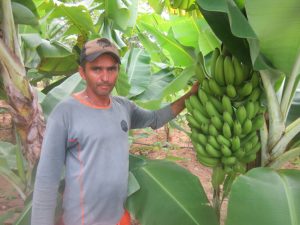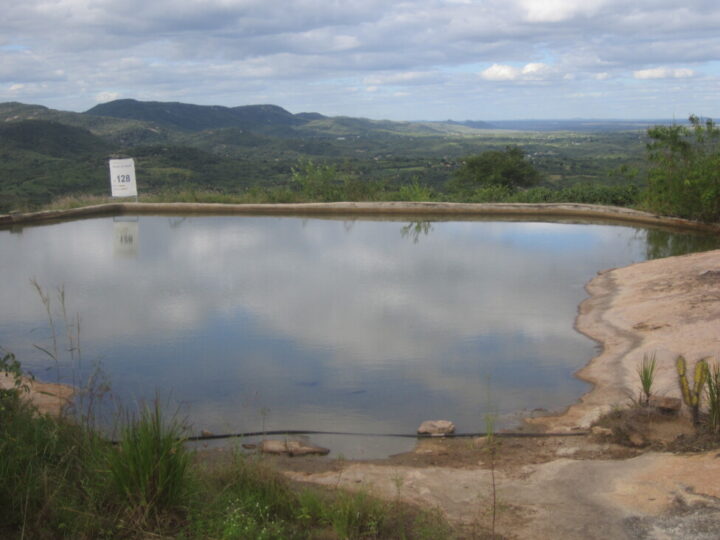
Eronildes da Silva proudly stands next to a bunch of bananas on his farm, whose large size is the result, he says, of the effective fertilizer of reusing waste water. In addition to farming, he drives a school bus and builds rainwater tanks in Afogados da Ingazeira, in Brazil’s semiarid Northeast region. CREDIT: Mario Osava/IPS
By Mario Osava
AFOGADOS DA INGAZEIRA, Brasil, Jun 30 2023 – “The rainwater tanks are the best invention in the world for us,” said Maria de Lourdes Feitosa, 46, who recalls the deadly droughts of the past in Brazil’s semiarid Northeast region.
“There has been a reduction of many diseases” that came from the so-called “barreros”, puddles and small ponds that are the result of the accumulation of water in muddy holes in the ground that people shared with animals, Feitosa, a farmer from a rural community in Afogados da Ingazeira, a municipality of 38,000 inhabitants, told IPS.
Feitosa owns a six-hectare farm and is less dependent on water than some of her neighbors because she produces agroecological cotton, which requires less water than horticultural and fruit crops.
Nearly 1.2 million tanks that collect 16,000 liters of potable rainwater from the roofs of homes now form part of the rural landscape of the semiarid ecoregion, an area that covers 1.1 million square kilometers and is home to 28 million of Brazil’s 214 million people, which extends throughout the interior of the Northeast and into the northern fringe of Brazil’s Southeast region.
The water tanks are a symbol of the transformation that the Northeast, the country’s poorest region, has been undergoing since the beginning of this century. During the longest drought in its history, from 2011 to 2018, there was no repeat of previous tragedies of deaths, mass exodus of people to the south and the looting of businesses by desperate people, as seen in the 1980s and 1990s.
According to the Articulação Semiárido Brasileiro (ASA), a network of 3,000 social organizations that created the program, adopted as public policy by the government in 2003, some 350,000 families are still in need of water tanks.

This 16,000-liter concrete slab tank stores rainwater collected on the roof and uses pipes to provide drinking water for Josaída Nunes and Eronildes Silva, in the Sertão de Pajeú, in Brazil’s semiarid Northeast. CREDIT: Mario Osava / IPS
Another battle is to increase fourfold the more than 200,000 “technologies” for collecting water for production, or “second water”, which already benefit family farming and are decisive for food security and poverty reduction in the region.
Reusing household water
Josaida Nunes da Silva, 38, and her husband Eronildes da Silva, 41, resort to reusing water from the bathroom and kitchen in their home, faced with shortages aggravated by the altitude of the hill they live on in Carnaiba, a municipality of 20,000 people bordering Afogados da Ingazeira.
A complex of pipes carries the wastewater to the so-called “fat box” and then to the Upflow Anaerobic Sludge Blanket (UASB) reactor and a tank for “polishing”, exposed to the sun, and another for the water ready for irrigation.
This system filters contaminating components, such as fecal coliforms (bacteria), and prepares the water with fertilizers for irrigation of the fields and fruit trees. “We grow lettuce, onions, cilantro and other vegetables, as well as bananas, corn, cassava, papaya, guava, passion fruit and even dragon fruit,” said Nunes.
Dragon fruit comes from the cactus family, of Mexican and Central American origin, and has recently become popular in Brazil.
The large size of the banana bunch is “proof” of the fertilizer’s effectiveness, said Nunes’ husband, who adds cow dung. “The treated water is a blessing. Besides providing us with water, it gives us good fertilizer,” Nunes said.

A “stone tank” that takes advantage of holes in the rocks to store rainwater is one of the technologies used to coexist with the scarcity of rainfall in Brazil’s semiarid Northeast ecoregion. In the background can be seen the mountainous landscape of the Sertão de Pajeú, in northeastern Brazil. CREDIT: Mario Osava / IPS
Her husband Silva is also a bricklayer and has built many water tanks in the region. He also drives school children from the rural area in an old van and keeps fodder for his ten cows in hermetically sealed plastic bags.
“The drought hit us hard. We had to bring water from the ‘barrero’ on the plain, up the mountain in the ox cart. We bought a cow, when she was still a calf, for 2500 reais and had to sell it for 500 reais (104 dollars),” lamented his wife.
The couple owns 8.5 hectares of land, a large property in the region where most farms are only a few hectares in size, the result of the frequent divisions between heirs of the large families of the past. But since the terrain is mountainous and rocky, the cultivable area is limited.
Nunes and Silva have three children, although only the youngest, 17, still lives with them.

Farmer Aluisio Braz (L) dries and threshes beans, accompanied by his wife, Joselita Ramos, on the terrace of their house that collects rainwater to fill the 52,000-liter tank at the back for agricultural irrigation on their farm in Carnaiba, in Brazil’s semiarid Northeast. CREDIT: Mario Osava / IPS
Coexisting with semiarid conditions
The techniques that benefit family farmers so that they can “coexist with the semiarid conditions” and prosper have been disseminated in the municipalities of the Sertão de Pajeú by Diaconia, a social organization of Protestant churches.
Pajeú is the name of the river that crosses 17 municipalities, whose basin is home to 360,000 people. The mountains surrounding the territory include the headwaters of several streams and creeks, which dry up in the dry season, but ensure greater humidity compared to other areas of the semiarid Northeast.
Agroecology practices are one of the focuses of Diaconia, whose agricultural technician Adilson Viana has dedicated 20 of his 49 years to supporting farmers and who accompanied IPS on visits to families involved in the program.
A tank that collects 52,000 liters of rainwater for production is the treasure of Joselita Ramos, 49, and her husband Aluisio Braz, 55, on their two-hectare farm, also located in Carnaiba.

The UASB reactor is an important component in the system for reusing bath and kitchen water for family farming in Brazil’s semiarid Northeast. CREDIT: Mario Osava / IPS
The rainwater falls on a concrete terrace on the ground that is about 200 square meters in size and is slightly inclined to fill the water tank. Braz uses it to dry and thresh string beans, which are typical of the Northeastern diet.
The couple grows fruit trees that Ramos uses to make pulp using mango, guava, acerola cherry (Malpighia emarginata) and a fruit native to the semiarid region, the umbu or Brazil plum (Spondias tuberosa), that comes from a small tree native to Northeast Brazil.
Ramos is taking a break from the activity “because it is not fruit season in the region and the energy to run the refrigerator is very expensive.” Another difficulty is that the city government’s payments for the pulp supplied to the schools have been delayed. “I only received a payment in November for sales from early last year,” she complained.
To boost the production of grains, such as beans and corn, as well as cassava, Braz grows them on his father’s four-hectare farm, about six kilometers from his own farm.

Ivan Lopes, an enterprising family farmer, shows a soursop plant that is highly productive thanks to irrigation with reused water and natural fertilizers, on his farm in Brazil’s semiarid Northeast. CREDIT: Mario Osava / IPS
Agroecological productivity
An exceptional case of entrepreneurial vocation and availability of water is that of Ivan Lopes, 43, who together with his brother grows fruit, including bananas, pineapple, mango, grapes, avocado, passion fruit and many more, on nine hectares of land.
Water is pumped from a lagoon on the property to four reservoirs located at the higher elevations, which make gravity irrigation possible. That is why electricity is one of the farm’s biggest expenses. “I plan to install a solar power plant to save money,” Lopes told IPS.
Honey is another product they make. “The last harvest totaled 40 liters,” from dozens of hives distributed throughout the orchard. Sugarcane is grown for the sale of sugarcane juice in the cities.
The farm is also a kind of laboratory for the dissemination of organic tomato cultivation in greenhouses. “At the agroecological market in São José do Egito (a neighboring city of 34,000 people) people line up to buy my tomatoes, because they are known to be clean, pest-free and tasty,” Lopes said.
Based on their experience, there are now 10 projects for tomato production in the Pajeú Agroecological Association.
To achieve his high level of productivity, the farmer makes his own fertilizer from earthworm humus. The success he has experienced in farming prompted him to get rid of his 10 cows in order to focus on crops and beekeeping.